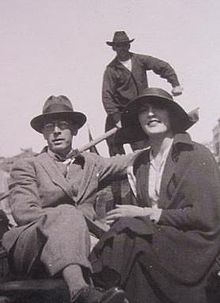Marcello Dudovich
| Marcello Dudovich | |
|---|---|

Dudovich with his wife in Venice (1910)
|
|
| Born |
21 March 1878 Trieste |
| Died | 31 March 1962 (aged 84) Milan |
| Nationality | Austrian / Italian (born in the Austro-Hungarian Empire, but the entire region transferred to Italy in the wake of the First World War) |
| Known for | Painting, Illustration, Poster art |
| Movement | Art Nouveau, called Stile Liberty in Italy |
Marcello Dudovich (21 March 1878 in Trieste – 31 March 1962 in Milan) was an Italian painter, illustrator, and poster designer. Together with Leonetto Cappiello, Adolfo Hohenstein, and he is considered one of the progenitors of Italian poster design.
Marcello Dudovich was born in 1878 to Serbian parents whose ancestors settled in Trieste, then part of the Habsburg Empire, from the town of Kotor in Montenegro. He attended the prestigious Royal School in Trieste. Upon completing his studies, he began working with his father as a lithographer and illustrator for advertising art, prints and posters.
He relocated from Trieste to Milan in 1897 after attending a professional art school. He was recruited as a lithographer by Ricordi, a music publisher, thanks to his father's friendship with the illustrator and cartoonist , and was given charge over advertisement design.
In 1899 he transferred to Bologna, working here for the publisher Edmondo Chappuis, designing billboards, book covers and illustrations for publications such as Italia Ride in 1900 e Fantasio in 1902. Here he met Elisa Bucchi, his future wife.
In 1900 he won the "Gold Medal" at the Paris World Fair.
In 1905 Dudovich returned to Milan to rejoin Ricordi. Here, in the next few years, he designed some of his well-known posters, including "Mele di Napoli" (Apples from Naples) and "Borsalino".
In the 1920s he made several posters for the Milan department store, La Rinascente, and in 1922 he was appointed artistic director of "Igap".
In 1930 he designed a prominent poster for Pirelli. After the Second World War he moved away from the world of commercial art, concentrating instead on his painting.
...
Wikipedia
